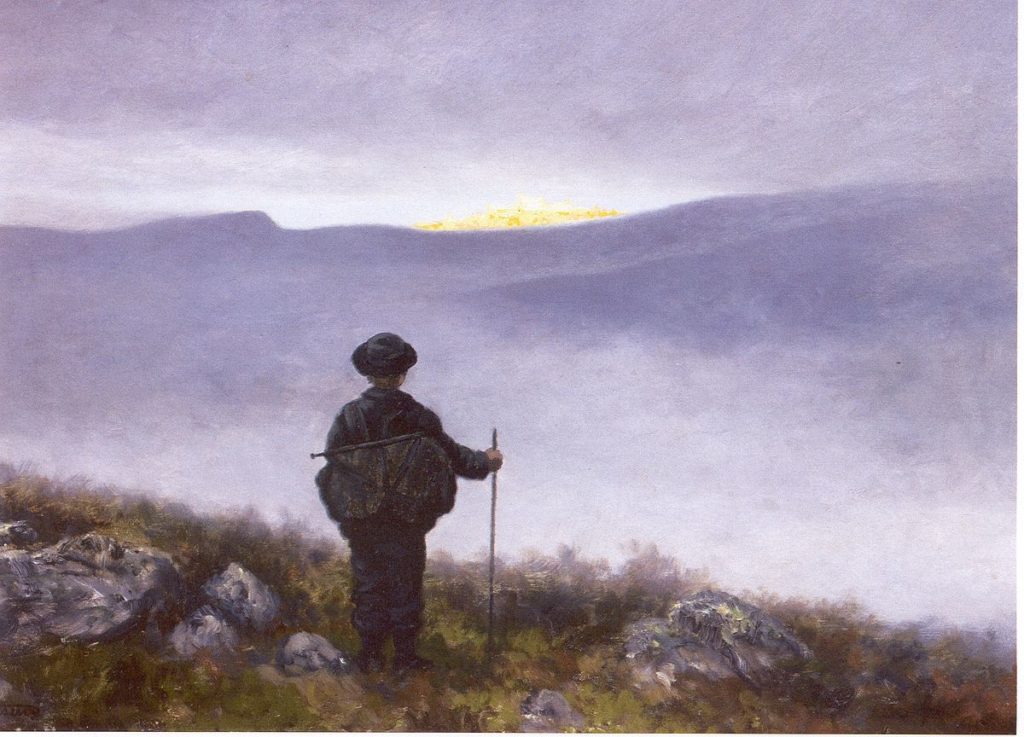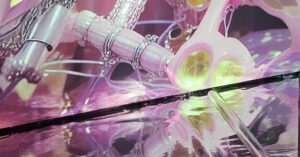Well, I already mentioned this tale a couple of times, talking about three-headed trolls, and now’s the time to feature it. These Sunday tales have been entertaining a lot of people and I’m really glad, considering that most of you come to my blog looking for entirely different things. So, let’s get to it.
It is probably going to be the last one I do from the Norse folk tales collection East of the Sun, West of the Moon, because all the others are frankly not up to my taste, but I’ll see what I can cook up for the cold, dark winter Sundays to come.
Soria Moria Castle
The tale (Soria Moria slott) is one of the tales collected by Peter Christen Asbjørnsen and Jørgen Moe in their Norske Folkeeventyr of which I recently bought (and gifted to a friend) the beautiful version illustrated by Kay Nielsen, published by Taschen. As it often happens, this particular tale was also collected by Andrew Lang and included the story in his series of fairy tale collections in The Red Fairy Book. It’s a particularly important book, among his collections, and it’s the one Tolkien himself had the chance to read and talk about.
1. The story
The tale features a recurring character, that I already mentioned as a sort of “nordic male Cinderella”, Askeladden or Askepot, as he appeared in Asbjørnsens’s first edition of 1843, and he’s portrayed as being at fault: he’s good for nothing else than sitting in the ashes, probably because we’re in Norway and the poor thing is freezing his ass off, and I’m sure Cinderella’s stepsisters had a similar opinion of her, so it really depends who’s telling the story. For some reason, George Webb Dasent translates the character as Boots in his XIX Century English translation.

Askeladden by Theodor Kittelsen (1900): the painting is in the National Museum of Oslo
In this particular tale, our ash boy is named Halvor and the story starts on the seaside: one day, a skipper asks our boy if he would like to go out at sea with him and a fierce storm blows them off course, having them stranded on stranger’s shores.
The boy wanders around and finds a castle, where a Princess is held captive by our usual three-headed troll. No matter how much our fair prisoner warns our boy, he refuses to leave and the princess gives him food, warms him and then sees opportunity: as it happened in The Three Princess in the Blue Mountain, she asks him to try and wield a sword, but the sword is too big for him. This time the solution comes in the form of a flask, whose content gives our hero enough strength to raise the sword and kill the troll.
Of course, princesse in Norse folk tales always come in groups of three: our newly-freed lady has other two sisters and each of them is held captive by a troll with an exponentially increased number of heads. Our hero defeats the six-headed troll and the nine-headed troll. The hero gets engaged to the youngest princess and they carry on happily for a while.
Then, as it happened in the Three Princesses of Whiteland, our lad misses his parents and the princess gives him a wishing ring, but once he’s at his parents our hero screws up: he wishes for the princess to be with him, to show her around and brag about his new wife, and she rightfully leaves him, after giving him a ring just in case.
Our hero buys a horse and sets off to look for his lost bride and meets lots of weird people, on his way: he finds an couple, a man and a woman, and the woman has a nose that’s so long she can poke the fire with it. He asks them about Soria Moria Castle, but they don’t know anything about it. The woman asks the Moon on his behalf, with no success. She then trades him his horse for a pair of magic boots, that are able to take twenty miles in a single step, and advises him to wait for the West Wind.

Another painting by Theodor Kittelsen (1881) depicting our lad in the search for Soria Moria.
The wind at last knows where Soria Moria Castle is and he takes out lad there, where the princess is getting ready to marry someone else. Our hero buys a cup for the lady, he puts inside the ring she had given him and gives her the cup: she recognizes him, and marries him instead of the new guy we know nothing about.
2. Themes
As we have already seen, the story is similar to others collected in the same book: we have a hero who finds a fabled land, he kills trolls of proressively increased level, he marries/is promised to the princess, he screws up, he has to look for his lost bride. Let us take a look, then, to a couple of the most original themes, particular to this tale.
2.1. The boots
Fairy tales are obsessed with feet and shoes and Cinderella is only the most famous of characters whose fate revolves around a shoe of some kind.
The partcular kind of boots we find in Soria Moria Castle are often referred to as seven-league boots, because of Charles Perrault and the usage he makes of them in his tale Hop-o’-My-Thumb. The most famous illustrations of this scene are by Gustav Dorè and Arthur Rackham.
They are a recurring theme all across Europe: the brothers Grimm collected an appearance of these kind of boots in their Sweetheart Roland, though in this tale they are worn by the evil witch in pursue of our hero, and in Great Britain we find them as a tool for Jack the Giant Killer, which is a very old tale and scholars have quarreled for ages about its origin; in Russian folklore, the item is called сапоги-скороходы (fast-pace boots) and in Finnish folklore they are sometimes referred to in a similar way. They are widely used also in modern tales, my favourite being Howl’s Moving Castle by British author Diana Wynne Jones, later made famous by Hayao Miyazaki in his 2004 animated movie.
Be careful, because the boots are often mistaken to be magical also in another tale made famous by Perrault, Puss in Boots, probably because the cat is talking and he does a lot of running about, but the boots have nothing magical: it’s all on the cat.
2.2. And who the fuck are you exactly?
There’s also another theme that we see is recurrent: the lady not recognizing his betrothed until a certain event happens, which in our Norse folk tale usually involves a ring. It’s a thing we also find in tales like Hind Horn, a traditional English and Scottish ballad, The Raven by the Brothers Grimm, involving an invisibility cloak, the fairly more complex Scottish folk tale The Rider Of Grianaig, And Iain The Soldier’s Son, collected by John Francis Campbell in Popular Tales of the West Highlands (1860–62).
3. Illustrations
3.1. Kay Nielsen
Kay Nielsen is the main guy, the artist responsible for me buying the tales. In my edition, he does two black and white illustration: the three princesse coming together at Soria Moria Castle, after being rescued, and the princess combing our lad’s locks to make him fall asleep (and leave him) after he misused his wishing ring. The first one is aesthetically beautiful, but take a look at how the second one chooses to depict the sun setting above the sea. Amazing.
3.2. Theodor Kittelsen
A fair amount of illustrations within this article, as you might have noticed, are by one Theodor Kittelsen, a beloved Norwegian artist I already talked about for fhe Three Princesses of Whiteland and for the Princess On the Glass Hill. He illustrated some editions of the Norse folk tales, including a black and white edition from 1930, but these paintings go way beyond. They were done back in 1881 for the publication in an edition of Norske Folkeeventyr in which this tale was written as a poem inside Ole Edvart Rølvaag‘s 1933 novel The Boat of Longing. A tale inside the tale.
3.3. Lancelot Speed
When Andrew Lang is featured, you know you can always count on either Lancelot Speed or Henry Justice Ford to illustrate your favourite folk tale. In this case, it’s the former. His illustrations of Lang’s Fairy Books is probably the work he’s most famous for, but he was also designer and director on early British silent movies, such as the 1916 version of the novel She by H. Rider Haggard, for which he had also done illustrations, or the Pip, Squeak and Wilfred adventures series.
3.4. Erik Theodor Werenskiold
I already talked about him here: he worked on the Norse tales around 1887 and was particularly fond of trolls. He is also know for his illustrations to the Norwegian edition of the Snorri Sturlason Heimskringla.
The edition fetured above has a weird typo, Soria Maria, which is particularly funny because it sounds a bit like Sóra Maria, something along the lines of Old Sister Mary used as you would use a female version of Hey dude!, but I guess it’s only funny if you’re Italian.
3.5. William Luden
So far I think we have seen nothing new, but in looking for illustrations to this widely popular tale I found this artist, who did charming illustrations of the Norse tales around 1936. I was able to find very little information on him, but you can see other works in this collection.
As far as modern illustrators go, I suggest you take a look at this blog: British illustrator Emma Margaret did a couple of illustrations for Soria Moria Castle and I’m in love with her charming scenery.
4. Influences: did anyone say Moria?
Of course I was going to talk about it. The name Moria is most famous not for being the fabled “sunset castle” of Norse fairy-tales, but for being the place of one of the grandest dwarven kingdoms in Tolkien’s Middle-Earth. It is located in the central parts of the Misty Mountains, and the Company has to cross its tunnels after having tried to unsuccessfully claim the pass of Mount Caradhras.
The place gets previously mentioned in The Hobbit, fairly early in the story, when the dwarves are still at Bilbo’s house and Gandalf argues with Thorin about how the map came to be in Gandalf’s possession. Since the first edition of 1937, Moria is the name of the place where Thror gets killed (though the name of Azog the Orc gets added only in 1966 for the Longmans/Urwin edition).
Tolkien candidly admits both the influence of the Norse legend and the casuality of it, basically sayin it was just a name he had heard somewhere and found it cool. He does so in August 1967, preparing an answer to one Mr. Rang who had inquiried about the origin of some names, an answer that was never sent.
Your remarks make me suspect that you are confusing Moria with Mordor: the latter was a desolate land, the former a magnificent complex of underground excavations. As to Moria, you are told what it means. III 415, and that is an Elvish (actually Sindarin) name = Black Chasm.
There’s a group of mountains in the Bible that are called in a similar way, and Tokien here is fighting to get away from people who see metaphores and mystical stuff in anything he wrote. Boy would he have a field day, right now.
As for the ‘land of Morīah’ (note stress): that has no connexion (even ‘externally’) whatsoever. Internally there is no conceivable connexion between the mining of Dwarves, and the story of Abraham. I utterly repudiate any such significances and symbolisms. My mind does not work that way; and (in my view) you are led astray by a purely fortuitous similarity, more obvious in spelling than speech, which cannot be justified from the real intended significance of my story.
It was there, as I remember, a casual ‘echo’ of Soria Moria Castle in one of the Scandinavian tales translated by Dasent. (The tale had no interest for me: I had already forgotten it and have never since looked at it. It was thus merely the source of the sound-sequence moria, which might have been found or composed elsewhere.) I liked the sound-sequence; it alliterated with ‘mines’, and it connected itself with the MOR element in my linguistic construction.
The same admission was previously found in a letter to journalist W.H. Auden, in June 1955, who had been asked to give a talk about The Lord of the Rings on the BBC Third Programme.
The Mines of Moria had been a mere name.
There’s also some notes about it in the guide he wrote for translators (forget the awful thing Christopher Tolkien published in “his” A Tolkien’s Compass and look for the real stuff incorporated by Wayne G. Hammond and Christina Scull – under the title Nomenclature – in their The Lord of the Rings: A Reader’s Companion, but there’s no further mention of Moria. It’s just a pretty name, to be left as it is.

















1 Comment
Pingback:#AdventCalendar 14: Sora Moria Castle – Shelidon
Posted at 19:12h, 14 December[…] few years ago, I did a commentary on this Norse folktale. This year, I give you the whole text. It comes from the 1912 English […]